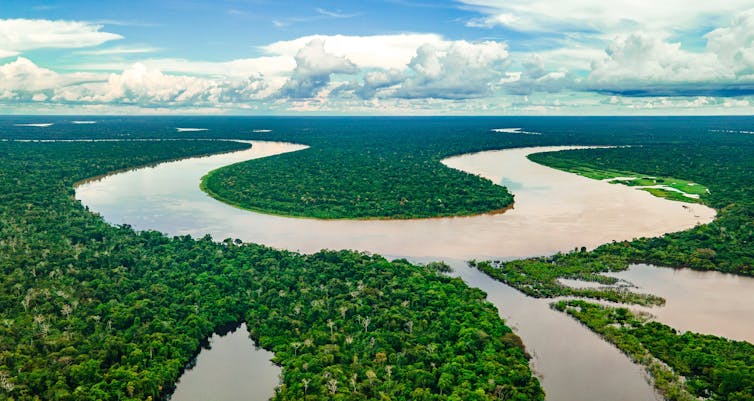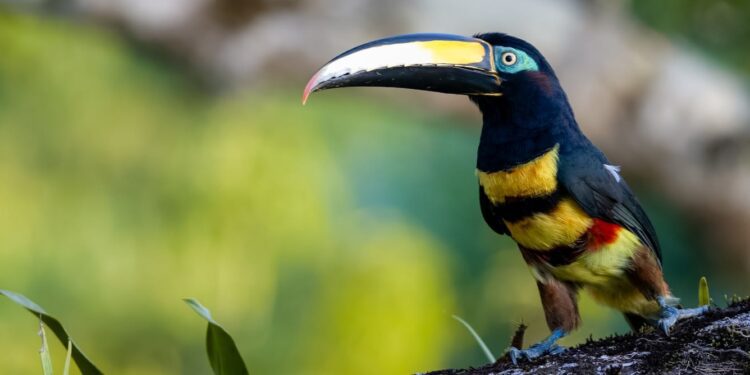Cattle ranches are the main driver of deforestation.
Jordi Romo / shutterstock
Things peaked in 2018, when 2,470 square kilometres of forest was lost in Colombia тАУ equivalent to a circular area more than 50 kilometres across. Rates of deforestation have reduced slightly since then (though the data isnтАЩt very reliable), but appear to be increasing once again in 2024.
The recent increase might be attributed to the demand to produce more coca or rear more cattle, along with pressure from extractive industries like mining. The spread of roads and other infrastructure further into the rainforest have also opened up new opportunities.
Billions more needed to stop deforestation
In its 2018 Living Forest Report, the WWF included ColombiaтАЩs Choc├│-Dari├йn and Amazon forests in its list of 11 тАЬdeforestation frontsтАЭ across the planet. These fronts are where it projected the largest concentrations of forest loss or severe degradation would occur in the period till 2030.
No wonder then that ColombiaтАЩs environmental crisis has drawn international attention. Countries like Germany, Norway and the UK have supported its efforts to reduce deforestation, pledging about тВм22 million under the UNтАЩs reducing emissions from deforestation and forest degradation scheme (known as REDD+). This is a good start, but much more is needed.

The Amazon winds through dense forest on the border between Colombia and Peru.
Jhampier Giron M / shutterstock
Indeed, the Global Biodiversity Framework, the international treaty that underlies the Cop16 negotiations in Cali, estimates weтАЩll need an extra US$700 billion each year to protect biodiversity.
An important issue at the summit is therefore how to mobilise sufficient financial resources, particularly for developing countries. The previous global biodiversity summit, held in Canada in 2022, established that wealthy countries should provide US$30 billion annually to low-income countries by 2030.
Ahead of this yearтАЩs summit, countries were expected to submit new national biodiversity plans detailing how theyтАЩll meet the 30% protection goals. Most failed to do so тАУ including Colombia. Despite this setback, delegates in Cali will hopefully develop robust mechanisms to monitor progress and ensure countries are held accountable for meeting their targets.
Other critical issues include reforms to benefit small-scale farmers in the Amazon. The regionтАЩs current economic model is centred on reshaping the land and extracting resources, but it has not generated prosperity for these more sustainable farmers. That same economic model has also failed to protect the forest itself.
The summit should also work towards recognising indigenous peoplesтАЩ rights and traditional knowledge, and including their voices in policy decisions, and must address violence against environmental defenders.
These are all huge issues in Colombia and indeed any country where cattle farmers are eyeing up pristine rainforest. The summit in Cali represents a great opportunity for the world to seriously tackle the dual biodiversity and climate crisis.

DonтАЩt have time to read about climate change as much as youтАЩd like?
Get our award-winning weekly roundup in your inbox instead. Every Wednesday, The ConversationтАЩs environment editor writes Imagine, a short email that goes a little deeper into just one climate issue. Join the 40,000+ readers whoтАЩve subscribed so far.
Source link : http://www.bing.com/news/apiclick.aspx?ref=FexRss&aid=&tid=671a93a8e71940a6ac1c0e1c817d9957&url=https%3A%2F%2Ftheconversation.com%2Fas-colombia-hosts-a-un-biodiversity-summit-its-own-amazonian-rainforest-is-in-crisis-241776&c=3510024466276305211&mkt=en-us
Author :
Publish date : 2024-10-24 03:26:00
Copyright for syndicated content belongs to the linked Source.












